Taking Measure
Just a Standard Blog
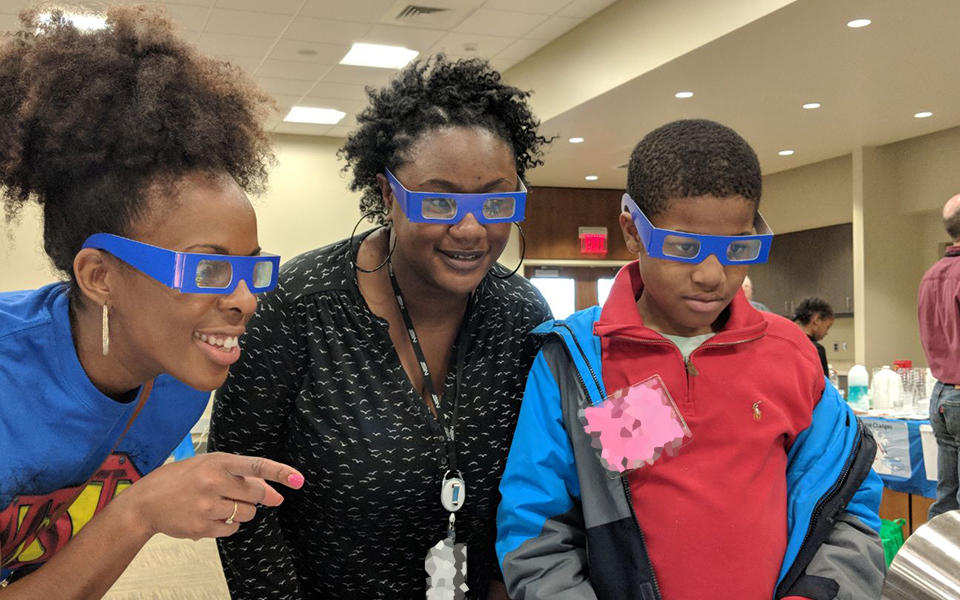
My mentee Troy (right), colleague Monique Johnson (middle), and I exploring STEM activities at the annual Take Our Daughters and Sons to Work Day at NIST.
Science, Technology, Engineering and Math (STEM) career outreach programs play a pivotal role in shaping the capabilities and makeup of the future workforce. Generally speaking, “STEM outreach” involves organizing events, both in and out of school, where we can encourage and inspire young people to consider pursuing careers in STEM by improving awareness and building STEM literacy. Attracting youth to STEM fields and retaining them, especially young women and minorities, requires the support of parents, teachers, role models (like me!) and professional organizations.
When I’m doing outreach, students and parents often ask what made me decide to pursue a career in STEM. My answer is simple: I was exposed early on to the endless opportunities that having a STEM degree affords you. My parents, both of whom were nuclear engineers at Westinghouse, seized every opportunity they could find to get my siblings and I involved in STEM. They were determined to get at least one of their children to follow in their footsteps. From computer camps to science museums to participating in “Take Our Daughters and Sons to Work Day,” we were constantly meeting STEM professionals and learning about different career paths.
While I ultimately ended up being the only one of my siblings to pursue a STEM career, I credit my passion for STEM education outreach to their efforts. I’ve made it a personal goal to continue their tradition and inspire as many students as possible to go into STEM.
STEM outreach activities are a great way to get students excited and interested in subject areas that are often deemed challenging by making them relatable to real-life situations. One of the things I love most is seeing the “light bulb” turn on in students’ heads the moment they understand a concept through hands-on learning. Participating in outreach activities also allows me to tap into my creative side because it requires me to come up with innovative ways to explain complex topics. Since starting my career at the National Institute of Standards and Technology (NIST) in 2011, I’ve had the opportunity to participate in many STEM outreach activities, both at NIST and externally. While I came to NIST to work as a chemist, I have since become an academic program manager in the NIST International and Academic Affairs Office (IAAO). Over the past few years, I’ve had the privilege to be an invited speaker and presenter at workshops and activities for students of all ages to explore the world of science.
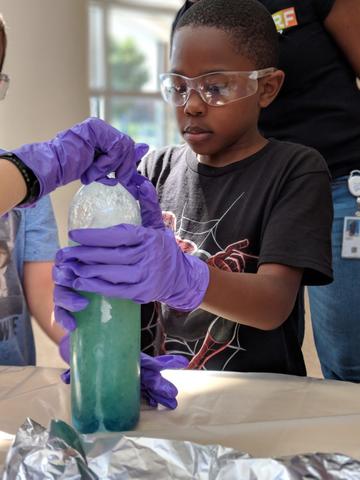
One of the main highlights from the past year was being invited to speak at the Black Women’s Agenda 40th Annual Symposium Workshop and Awards Luncheon. In 2014, the Black Women's Agenda, Inc., launched "Inform & Inspire" — a series of workshops that give middle school girls a chance to explore STEM careers and meet African-American women working in these fields. I was asked to join a dynamic panel that featured Miss USA 2017 Kára McCullough, a former physical scientist at the Nuclear Regulatory Commission, and Gwendolyn Boyd, a prominent mechanical engineer and civic leader. During a candid discussion about our different career paths, we encouraged the girls to embrace their uniqueness and gifts, set goals, and work hard to realize them. After our initial meeting, McCullough asked me to join forces with her to work on the launch of the nonprofit, Science Exploration for Kids (SE4K). SE4K offers a variety of interactive science-related programs for students in grades K-12. SE4K’s learning programs focus on teamwork, self-confidence and career development, all while having fun. In March 2018, we held our inaugural event, Take Flight with SE4K, in the Ronald Reagan Washington National Airport’s historic Terminal A in Arlington, Virginia. We welcomed over 75 students from across the region to participate in hands-on demos, raffles for prizes and science exploration stations.
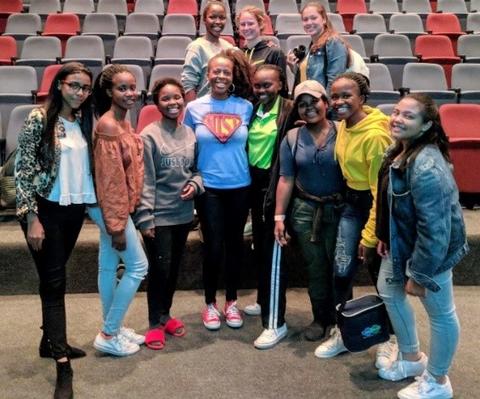
In addition to my work with SE4K, I also had the wonderful opportunity to attend the 22nd annual Scifest Africa in South Africa. I began working with the organization in 2015 when I was selected as an Embassy Science Fellow. During my initial three-month stay, I worked as an Outreach and Logistics Officer for the Festival and coordinated more than 80 exhibitions and 600 events to be presented at the festival by 345 contributors from 100 participating organizations from 13 different countries.
Additionally, I led an outreach team that traveled to different local and rural regions to lead interactive workshops at several schools and the Nelson Mandela Bay Science and Technology Centre. During those trips, my team engaged with almost 6,000 students, educators and members of the public.
Since my time as a fellow, I have returned to the festival each year as a NIST ambassador and a guest speaker. This year, I developed three new hands-on workshops to be included in the program. These workshops reached over 500 students and focused on fundamentals of chemistry, engineering and biology. I also had the opportunity to speak with a group of teenage girls about how to overcome the barriers that they might face when pursuing a career in STEM. I even appeared on the ETV Sunrise Show, a South African morning news show, to help spread the word about the festival. This experience really solidified my passion to communicate the relevance of science and my commitment to mentor young people. I have truly enjoyed engaging with learners, educators and parents through Scifest Africa and look forward to continued collaboration with the organization.
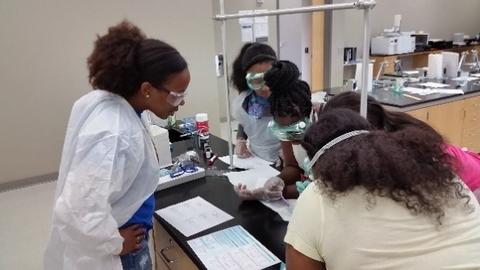
Another recurring outreach project that I anticipate each year is with STEMversity, a nonprofit located in Milledgeville, Georgia, that offers training and educational programs for those preparing to enter college or the workforce, especially in areas that have historically lacked diversity. In 2016, NIST awarded STEMversity a three-year Measurement Science and Engineering Research grant to support the advancement of the program. In partnership with Baldwin County Schools, Georgia Technical College, Georgia College Early College, NIST, the Air Force Technical Applications Center, the Drug Enforcement Administration and the Office of Forensic Science, STEMversity has created a platform to expose underserved and underrepresented middle and high school teachers and students to forensic science. Regina Easley from NIST’s Chemical Science Division and I have attended and presented to the group four years in a row now. The students’ responses to the workshops have been overwhelmingly positive. Several of the repeat attendees told us how much they look forward to the new and interesting concepts we bring for them to learn.
One of the things I love most about NIST are the many ways for staff to participate in outreach. Two of our biggest events took place in April 2018: the 5th USA Science and Engineering Festival in downtown Washington, D.C., and the annual Take Our Daughters and Sons to Work Day. I have worked at both events in the past, but this was my first year participating in the planning and coordination process. I was so impressed by the dedication and commitment of the staff members that spent hours behind the scenes to create these two high-quality events.
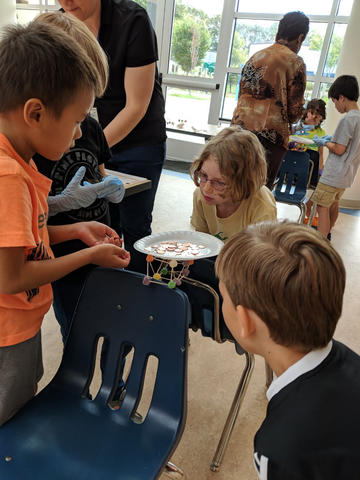
Another on-campus initiative that I am excited to be doing this year is S.T.E.A.M. Forward!, which I launched last year specifically for the kids at the NIST Child Care Center. It features weekly interactive, low-cost, hands-on activities that explore topics related to the different career paths at NIST. Over the course of five sessions, we focus on introducing the kids to topics such as separation science, chemical changes, engineering and building processes, pH and buffers, density, surface tension, polymers, and factors that impact the environment. We also do a few “wow” factor demonstrations like foam gnomes and Mentos geysers. Throughout the program, I’ve heard several students saying, “Science is so cool!” and “I wish we could do experiments every day!” Overall, the children and staff at the Child Care Center thoroughly enjoyed the S.T.E.A.M. Forward! summer program and are happy that it has returned for a second year. One parent even mentioned how their child used one of the demos that they learned last year as the foundation for their science fair project. My hope is to continue to grow the program and make it available year-round.
I’m strongly committed to the development of a diverse STEM workforce through continued engagement with students at every level of their academic career. I’ve been able to use my interest in science communication to popularize science and help increase awareness about opportunities in the STEM field. If we are to maintain technological and scientific leadership, I believe it’s essential that we continue to make outreach a priority to attract and recruit highly qualified individuals for the STEM workforce.
About the author
Related Posts
Comments
WHY are we recruiting in Africa when we have MANY intelligent Americans, particularly in rural and suburban America that are NOT being given STEM opportunities?
A major factor for the US Opiod epidemic is a LACK of opportunities for Americans.
We have MANY Americans graduating college, some even with PhD & MS degrees that can NOT find jobs.
It should be remembered that diversity means ALL races.
It is very disappointing that recruiting in Africa is more of a priority than recruiting in rural and suburban America.
Thank you for your interest in our STEM education outreach blog post. The post is the author's firsthand account of her recent public engagement efforts through STEM outreach in the U.S., as well as internationally.
The author’s STEM activities in South Africa were not related to recruitment. She traveled initially to South Africa as an Embassy Science Fellow. The Embassy Science Fellowship was established by the U.S. Department of State as an effort to provide U.S. embassies and their affiliate organizations access to the expertise of U.S. government officers in science and technology fields. Her activities were solely to share the excitement of STEM activities so that African students would consider STEM careers in their own countries.
We agree that U.S. STEM enrichment activities should be shared throughout the United States including rural areas. NIST supports this goal through NIST’s Summer Institute for Middle School Teachers and other programs. We also draw your attention to the author’s efforts in Washington, D.C., Maryland, and Georgia mentioned in the post. Please keep in mind that the examples cited in this blog post are not fully representative of the extent of her outreach efforts in the U.S.
NIST strives to establish and maintain a workforce that reflects the diverse U.S. population and promotes an environment that respects and values individual differences. NIST recognizes that the ability to attract, develop, and retain a skilled workforce is key to the Institute’s continued success and must be viewed and treated as a top priority. Your feedback is appreciated and we look forward to sharing more insight through our blogs in the future.
Sincerely,
Mark Esser
NIST Taking Measure blog editor





Faculty and Staff of Tennessee State University send you warm congratulations. Glad to have you as our Chemistry alumni